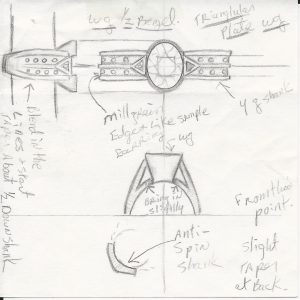I have seen that many online educational videos tend to assume that you have some experience with bench work. Many also assume that you have access to tools. Lots of tools. Very expensive tools. This was a pet peeve of mine when I was just starting in the 80's and it seems that nothing has really changed.
-
-
This video shows how to make a basic, but often used tool at the jewelers bench. The sanding stick. You should make several of these in different grits of paper.
-
At first glance it looks remarkably like a skirt hook, but the size of it makes me doubt that. Most likely half of a clasp set for a pouch or a neckline. It could be the hanging end of a small chatelaine. it could possibly be for winningas as well.
-
A great example of how things change. Look at your engagement or wedding ring. Is it a Tiffany style solitaire? If so, I have some trivia for you.
-
There are very few things that can be said that are the same for every jewelry store out there, but one of them is that if you ask and dig around at the very back of the safe, you will find a box.
-
Every jeweler starts somewhere This page is where I will share information that I have learned over the years.
-
As an artisan, when asked to create a proposal for regalia, I normally have a conversation similar to the following.
-
When I was in college taking an "Economics 101" class, I remember having this one point hammered over and over again: "The law of supply and demand states that a low supply and high demand for any product or service will typically increase its price". That brings me to the title of this post. "Buying Scarcity". After some basic info, I will tie it into the jewelry trade.
-
Now I have nothing against selling jewelry. I did it for many years. I just do not want to mislead others into thinking that they cannot adequately clean their own jewelry, and I do not like using gimmicks to get you back into a store to sell you something.
-
Deconstruction is a process to understand how something was created. Mostly used in writing, it is also used in art.It is looking at the “components” to see how they make the “whole”, whether that is a piece of writing, a building, a favorite chair, a ring… Deconstruction looks at the smaller parts that were used to create an object. This gives insight into the mind of the person who created it. In some ways, it lets their thoughts and ideas continue to live centuries after they have passed. The smaller parts are usually ideas.
